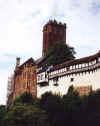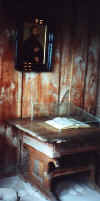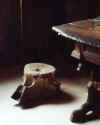|


| |
 |
Wartburg is the fortress/castle (photo A) near
Eisenach in which Luther was hidden (May 1521-February 1522) by Elector
Frederick after the Diet of Worms. Built in the 12th century, the Wartburg
is the best surviving example of a late Romanesque secular building north
of the Alps. While here Luther translated the New Testament into German. |
Facts and Photos
The Diet of Worms in April 1521 was the first imperial Diet convened by
Emperor Charles V, who had been elected in June 1519. Hoffman writes: "For
the Diet of 1521, a host of problems were on the agenda. Above all the emperor
wanted to obtain money and troops from the Germans to counter the threats to the
Empire from the Turks and the French. The imperial supreme court and imperial
regiment were also to be topics of discussion. The `Luther Affair' was supposed
to be taken care of on the side; instead it overshadowed the entire diet and
turned into a test of strength between the imperial estates and the
emperor" (220). Through the political maneuvering of the Elector of Saxony,
Frederick the Wise, Luther was granted a hearing before the Diet. He came
expecting an opportunity to debate the issues. Instead he was asked, "Do
you or do you not repudiate your books and the errors which they contain?"
Luther answered, "Unless I am convicted by Scripture and plain reason–I
do not accept the authority of popes and councils, for they have contradicted
each other–my conscience is captive to the Word of God. I cannot and I will
not recant anything, for to go against conscience is neither right nor safe. God
help me. Amen. Here I stand, I cannot do otherwise."
 On
his return trip to Wittenberg, he was "kidnapped" by Elector
Frederick's people and taken into hiding at the Wartburg for his own safety,
since he was declared an outlaw in the Edict of Worms. To ward off his feelings
of doubt ("Are you alone wise? Have so many centuries gone wrong?")
and depression brought on by his isolation, Luther wrote several treatises and
translated the New Testament into German. Kittelson writes: "Luther
translated the entire New Testament into German within 11 weeks. Like a man
possessed, he worked at the rate of more than 1500 words per day. What he
produced was so masterful that in time it did much to create the modern German
language" (175). On
his return trip to Wittenberg, he was "kidnapped" by Elector
Frederick's people and taken into hiding at the Wartburg for his own safety,
since he was declared an outlaw in the Edict of Worms. To ward off his feelings
of doubt ("Are you alone wise? Have so many centuries gone wrong?")
and depression brought on by his isolation, Luther wrote several treatises and
translated the New Testament into German. Kittelson writes: "Luther
translated the entire New Testament into German within 11 weeks. Like a man
possessed, he worked at the rate of more than 1500 words per day. What he
produced was so masterful that in time it did much to create the modern German
language" (175).
 Luther
lived in two rooms in the castle warden's house at the Wartburg–a small,
windowless room for sleeping, and a larger room with a window for writing (photo
B, above). The picture above the desk is a copy of Cranach painting of Luther as
"Knight George," with full beard–his disguise while in hiding. The
present furniture is not original, with the possible exception of the whalebone
(Photo C), which Luther is said to have used as footstool. Luther
lived in two rooms in the castle warden's house at the Wartburg–a small,
windowless room for sleeping, and a larger room with a window for writing (photo
B, above). The picture above the desk is a copy of Cranach painting of Luther as
"Knight George," with full beard–his disguise while in hiding. The
present furniture is not original, with the possible exception of the whalebone
(Photo C), which Luther is said to have used as footstool.
Reflections
As a typical tourist/pilgrim, I wanted to buy inexpensive, easily
transportable, nice (versus kitsch), and meaningful souvenirs at every place I
went. I was often less than successful. In Eisleben I bought two coasters with
Luther's seal on them and carefully wrapped them in socks to transport them
safely. In Dresden while unpacking, one fell out on the floor and broke. I loved
Aachen and hunted in the souvenir shops for something tasteful, but had to
settle for a rather kitsch item–a bronze paperweight of the cathedral, which
now graces my desk. In Wittenberg I bought "Luthersocks" for Mark and
me. Woven into the ankle part of the sock are the words (in German) "Here I
stand. I can do no other." I have worn mine with pride on Reformation Day
and Luther's birthday. But the one thing I bought which met all my criteria was
an item I got at the Wartburg gift shop–a German New Testament paperback
subtitled "Luther-Übersetzung" (Luther translation); actually, it's a
twentieth-century revision by the German church, but it's still based on his
work.
Several years I was reminded of how we take for granted having the Scriptures
easily available to us in so many different English translations when I visited
a local church with a Concordia student, Truc Bi, a young Vietnamese woman. A
Bible society group that does translation work was speaking after the service,
and Truc Bi asked me if we could stay. I never would have done so, had I been
there on my own. But this particular organization had worked on the Bible
translation in Truc Bi's native tongue, and so for her there was a powerful
connection. Around the world there are still language groups today that have the
same experience the German people did in the sixteenth century–hearing and
reading for the first time the Word of God in their native language, and having
affordable copies of the Scripture made available for private and personal study
of God's Word. |
